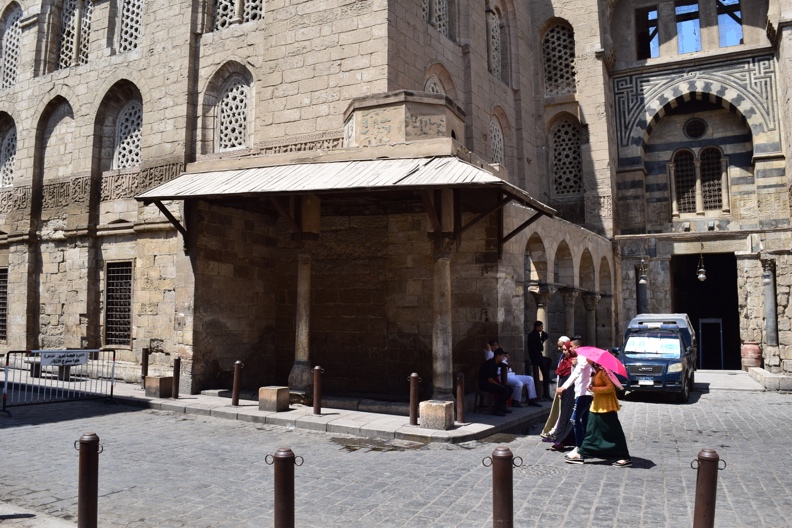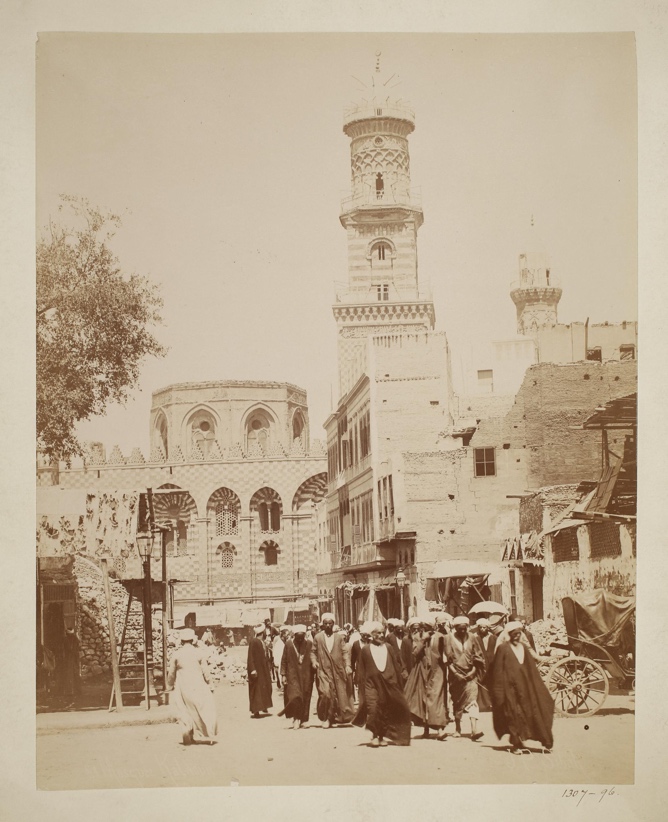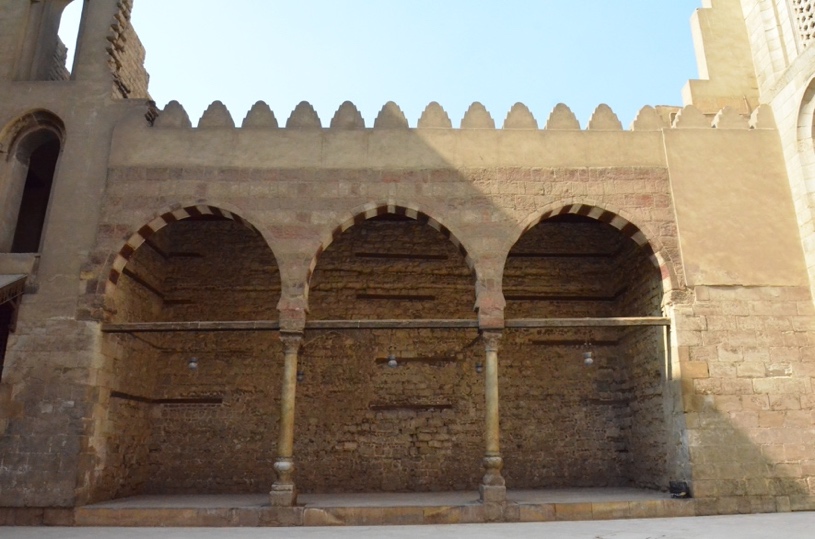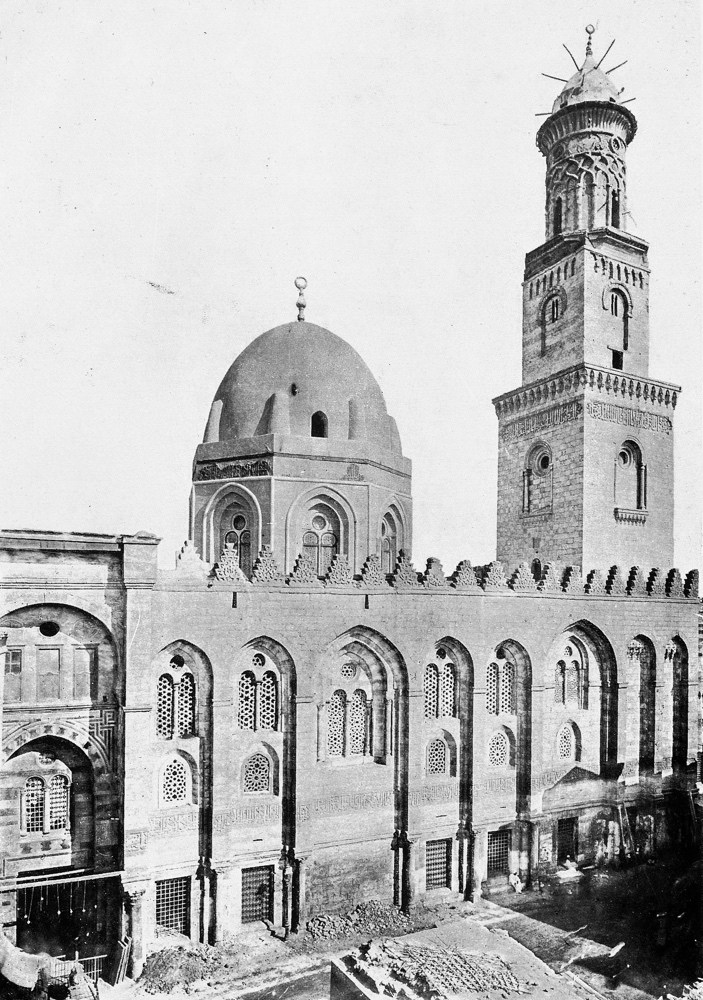Construction and Renovations
(1) Initial Construction of the Complex under Qalawun
The Qalawun charitable endowment complex consists of three main facilities: a mausoleum, a madrasa, and a hospital. According to the inscription above the entrance, the entire complex was constructed in only 13 months (June–July 1284 to July–August 1285), which was exceptionally fast for that era. The hospital was completed at the end of the year construction began. Next, construction of the mausoleum began around December 1284 or January 1285, and was completed within four months. And madrasa construction began around April-May 1285, and was completed in July-August that same year.1。
1 Behrens-Abouseif, 2007: 134.

The complex was completed in such a short time because the construction work was carried out in a rather brutal manner. It began with the eviction of occupants from the Quṭbīya residential area2 in the site planned site for the hospital3. In addition to the Cairo and Fustat craftsmen recruited for the work, it is said that even passers-by were forced to work at the construction site4. Construction is also said to have used hundreds of Mongolian prisoners of war taken in battles with the Il-khanate5. Also, other buildings were destroyed to provide the materials to build the hospital6. Because of these issues, some legal scholars went as far as issuing fatwās (legal opinions) that worship there was not permissible7.


Columns of different heights near the entrance. These columns appear to be reused. Such reappropriated elements are found throughout the facility.
2 The site of the west royal palace of the Fatimid dynasty, where the Qalawun hospital was later built, was in the late Ayyubid dynasty (1169–1250) the residence of Quṭb al-Dīn Aḥmad, the son of Ayyubid Sultan al-‘Ādil I (reigned 1200–1218). It therefore was known as “the Quṭbīya’s Residence”. Khiṭaṭ, 4: 692.
3 Ta’rīkh Ibn al-Furāt, 7: 278.
4 Khiṭaṭ, 4: 698.
5 Northrup, 1998: 122.
6 Khiṭaṭ, 4: 698.
7 Khiṭaṭ, 4: 698.
According to the endowment document (waqfīya), Qalawun mainly donated real estate in the city. Income generated from the real estate was used to build and maintain the complex. According to contemporaneous accounts, most income from his donation was allocated to the hospital. Al-Maqrīzī (died 1444), a prominent historian during the Mamluk era, estimated that income to be 1 million dirhams (50,000 dinars) annually8. Among the donated real estate were qaysārīyas (courtyard-style commerce facilities) and a ḥammām (bathhouse) near the Qalawun complex9.
8 Khiṭaṭ, 4: 696. The endowment document do not specify how much of the total income from the donated properties was allocated to each facility.
9 Mamluk-era encyclopedist al-Nuwayrī (died 1332), who was engaged in the management of the hospital, wrote that many other donations helped support the operations of the hospital. These are believed to include some properties donated after construction was completed(Nihāya, 31: 106)。
(2) Expansion and Renovations
After Qalawun’s death, the sultans that succeeded him made additional property donations, expanding the complex’s financial resources. Qalawun’s son and successor, Sultan Khalīl (reigned 1290–94), endowed land in the cities of Tyre and Acre to his father’s mausoleum. This was his way of sharing with his late father the spoils of military campaigns against the Crusaders in Syria and Palestine. He also endowed real estate in Cairo to his father’s madrasa10. Qalawun’s grandsons Sultan Abū Bakr (reigned 41) and Sultan al-Ṣāliḥ Ismā‘īl (reigned 1342–45) also donated to the mausoleum11.
10 Sulūk, 1: 769; Khiṭaṭ, 4: 523.
11 See Sulūk, 2: 623 regarding donations by Sultan Abū Bakr. See Khiṭaṭ, 4: 518 regarding donations by Sultan al-Ṣāliḥ.
In 1325, 40 years after the complex was consecrated, Qalawun’s son Sultan al-Nāṣir Muḥammad (reigned 1294–95, 1299–1309, 1309–1340) undertook the first full-scale renovation. Amir (military commander) Āqūsh al-Ashrafī was in charge of this work. He carried out large-scale construction, such as renovating the hospital īwāns, decorating the exterior walls, and installing a sabīl (public water fountain). A sunshade was also installed, to protect the shops outside the facility from the sun. These construction projects took five months, and were all paid out by Āqūsh. Historian and encyclopedist al-Nuwayrī (died 1332) reported as follows:
Amir Āqūsh instructed the hospital not to leave any sick behind. People who had been there (in the hospital) from before were expelled. The sick and many wards were removed from the (hospital’s) īwāns, leaving nothing in the hospital except patients with mental conditions and some others with medical conditions. Then, the renovation [actually] began at the facility. When the renovation work began, coats of plaster and varnish were applied, and the outer walls of the mausoleum, madrasa, and minaret were carved with chisels (azāmīl). The renovation work continued until (the month) Jumada I (April-May 1326). From the beginning of that year until Tuesday the 11th of Jumada I, the four īwāns of the hospital were empty. On this day, Āqūsh ordered the medically ill to be returned (to the hospital). The total cost of this repair work was just under 60,000 dinars. (Nihāya, 33: 202–203)
Historian al-Maqrīzī (died 1444) reported as follows:
When Amir Āqūsh, the Governor of al-Karak, was appointed trustee of the hospital in 1326, he added a ward for the sick and decorated the walls of the building with stone, making (the building) look like it had just been built. The exteriors of the madrasa and the mausoleum were repainted with gold paint, and a sunshade of 100 dhirā‘ (1 dhirā‘ is about 66.5 cm) was installed, extending from the wall of the mausoleum adjacent to Sultan al-Nāṣir Muḥammad’s madrasa to Qalawun’s madrasa directly opposite al-ṣāgha (the sūq where the metalsmiths are concentrated). This was to protect the various street stalls (where goods for sale were spread out) that sell small containers from the heat of the sun. Ropes were installed to cover them (unfurl and spread the awning to cover the line of street stalls) when it was hot, which could be folded when not in (direct) sunlight. It was placed up high. In addition, a water trough for livestock was moved from near the hospital gate (to another location). The excrement that accumulated in front (of the original water trough) stank and offended people, and it was therefore removed (from in front of the hospital). In place of the (livestock) water trough, a sabīl (public water fountain) was installed at the hospital entrance, so that people could drink water from it. (Khiṭaṭ, 4: 697)

(3) Renovations Since the Early Modern Period
In 1776, hospital supervisor ‘Abd al-Raḥmān Katkhudā undertook major renovations. As a part of these renovations, the domes above the antechamber and the mausoleum were removed, while the residences on the south side of the madrasa were demolished and an arcade was installed there.
Source: Photograph in the Victoria and Albert Museum taken by Jean Pascal Seba
Image source: V&A Museum (http://collections.vam.ac.uk/item/O1277147/the-mosque-of-mamluk-sultan-photograph-sebah-jean-pascal/#)


Then, in the early 20th century, major renovations were carried out by the Comité de Conservation des Monuments de l’Art Arabe, which oversees the management and preservation of historic buildings and archaeological sites. The Qalawun complex we see today is the result of those renovations. A concrete dome was installed above the mausoleum, which had stood roofless for over a century12. Uncertain of the original dome design, renovation work director Max Hertz (died 1919) patterned the new dome after that of the Sultan Khalīl Mausoleum. The interior of the mausoleum was also restored at this time.
12 Behrens-Abouseif, 2007: 138.
Source: Unknown photographer
Image source: Wikimedia Commons (https://upload.wikimedia.org/wikipedia/commons/0/0b/Qalaun_after_restoration.jpg)

References
Primary sources:
Khiṭaṭ: al-Maqrīzī, Taqī al-Dīn Aḥmad ibn ʿAlī ibn ʿAbd al-Qādir. 2002–04. al-Mawāʿiẓ wal-Iʿtibār fī Dhikr al-Khiṭaṭ wal-Āthār. London: al-Furqān Islamic Heritage Foundation.
Nihāya: Nuwayrī, Aḥmad ibn ʻAbd al-Wahhāb. 1923–55 (vol. 1–18); 1975–92 (vol. 19–31). Nihāyat al-Arab fī funūn al-adab. 31 vols. Cairo: Maṭbaʻa Dār al-Kutub al-Miṣrīya.
Sulūk: al-Maqrīzī, Taqī al-Dīn Aḥmad b. ‘Alī b. Abd al-Qādir. 1939–73. Kitāb al-Sulūk li-Maʻrifat Duwal al-Mulūk. 4 vols. Cairo: Maṭba’a Dār al-Kutub al-Miṣrīya.
Ta’rikh Ibn al-Furat : Ibn al-Furāt, Muḥammad ibn ʻAbd al-Raḥīm. 1936. Ta’rikh Ibn al-Furat. Bayrūt: al-Maṭba’a al-Amirkānīya.
Secondary works:
Behrens-Abouseif, Doris. 2007. Cairo of the Mamluks: a history of the architecture and its culture. Cairo, Egypt: American University in Cairo Press.
Northrup, Linda Stevens. 1998. From slave to sultan: the career of Al-Manṣūr Qalāwūn and the consolidation of Mamluk rule in Egypt and Syria (678-689 A.H. /1279-1290 A.D.). Stuttgart: F. Steiner.
English translation: Jeff Gedert